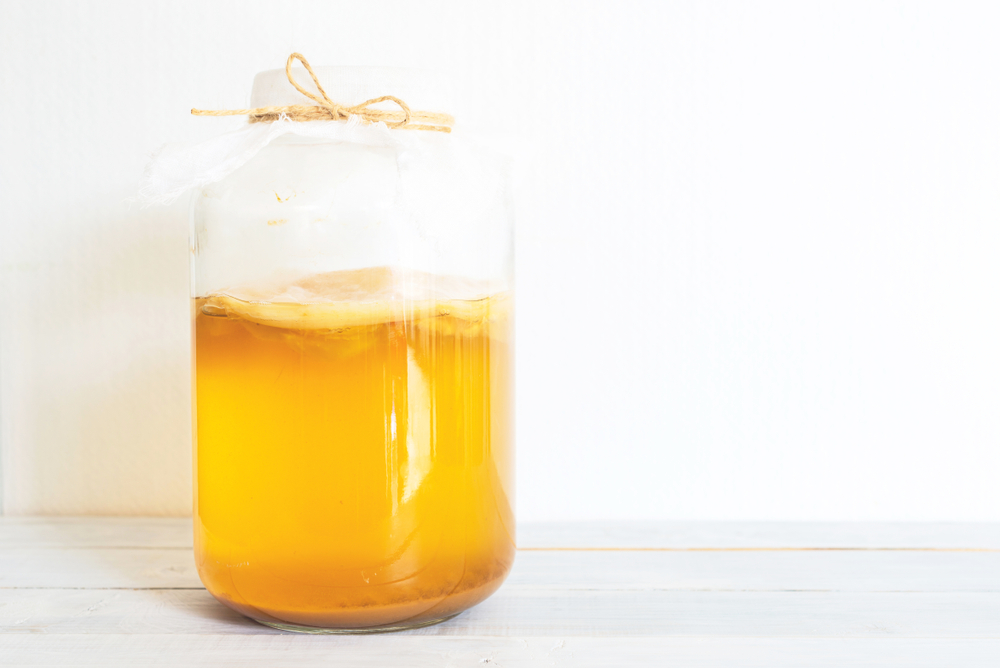
Kombucha is a fermented beverage made from tea and a source of sugar. Although plain (unflavored) black tea is perhaps most commonly used, white tea or even mildly flavored varieties will also produce an enjoyable kombucha end-product.
Although there is a lack of published, peer-reviewed scientific proof that regularly drinking kombucha cures diseases or health imbalances, many people insist that they have found relief from ailments such as digestive distress, fungal overgrowth and even menstrual cramps when making kombucha a feature in their daily diet. Made from a culture (also known as a ‘mother’ or ‘scoby’) comprised of beneficial yeast and bacteria, kombucha is created when the microorganisms in the culture reproduce, living off the sugar in the original tea mixture and putting off carbon dioxide gas, creating a somewhat tart or vinegar-tasting liquid which is slightly carbonated. Upon completion of the fermentation, a second culture or mother will be formed, which can then be used to make additional kombucha batches.
Learning how to make kombucha at home requires only a small amount of work and tender love and care, and will yield plenty of liquid time and time again. By obtaining an initial culture, you can literally be making kombucha for years and years to come. Recipes vary slightly with regard to the amount of tea and sugar (and feel free to experiment according to your taste preferences!), but here is a basic recipe which we like to use at home:
Ingredients*:
- 6 cups filtered water
- 2 tea bags or 2 tbs loose tea (contained in a boule/tea strainer)
- 1/2 cup raw sugar or palm sugar
- Kombucha culture/mother/scoby
- 1/4 cup kombucha tea or white vinegar
Preparation & Primary Fermentation Instructions:
Place the water, tea and sugar in a pot on the stove and bring to a boil. Turn off heat and let sit for approximately 1 hour. Remove tea bags or loose tea and let liquid cool to room temperature. Pour into a large glass container or jar, and deposit kombucha culture into the liquid (may either sink or float to the surface). Add in kombucha from a previous batch or the vinegar and cover the lid of the container with a breathable piece of fabric (e.g., cheesecloth, a nut milk or sprouting bag). Fabric cloth may be secured around the mouth of the container with a rubber band to prevent contamination or insects from gaining access to the liquid (you can get a jar with a lid and cheesecloth all together in a set here). Let mixture sit in an area away from direct sunlight or excessive heat for 1-3 weeks, depending on your preference (kombucha liquid will become less sweet and more tart over time – taste to determine when it is most palatable for you).
Bottling & Secondary Fermentation Instructions:
When you are ready to decant your kombucha, you can either drink it as-is, flavor it, or let is undergo a secondary fermentation, which will achieve slight carbonation. To drink as-is, decant from original glass container into smaller jars with lids and store in the refrigerator until ready to enjoy. To flavor, add fresh-pressed fruit juices, for example or dried fruit to the individual jars before storing. To ferment further, decant into jars or containers with lids and remain at room temperature for another week, approximately. A small amount of sugar may be added to the jars in order to increase the fermentation and therefore carbonation. Take care not to leave your kombucha at room temperature in a closed container for too long, as excess carbonation may be achieved (corked bottles are a good safety measure to prevent breaking glass in the case over over-carbonation).
The resulting new culture which was produced may be used to create additional batches of kombucha, and can also be stored for later use in an airtight jar with a little bit of reserved kombucha liquid.
*Recipe can be doubled if you have a larger container/jar.
Some of the links on this page may be affiliate links. Jennifer M.S. Robertson, LLC is a participant in the Amazon Services LLC Associates Program, an affiliate advertising program designed to provide a means for us to earn advertising fees by linking to products mentioned. If you purchase a product through an affiliate link, your cost will be the same, but Jennifer M.S. Robertson, LLC will automatically receive a small commission.


I had no idea you could make kombucha at home with some basic ingredients. I wish I lived close by to get some of the cultures from you. Can I use the jar kombucha found at whole foods as a culture?